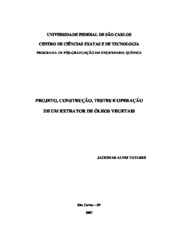Mostrar el registro sencillo del ítem
Projeto, construção, testes e operação de um extrator de óleos vegetais
| dc.contributor.author | Tavares, Jaciomar Alves | |
| dc.date.accessioned | 2016-06-02T19:56:29Z | |
| dc.date.available | 2009-05-22 | |
| dc.date.available | 2016-06-02T19:56:29Z | |
| dc.date.issued | 2006-03-02 | |
| dc.identifier.citation | TAVARES, Jaciomar Alves. Projeto, construção, testes e operação de um extrator de óleos vegetais.. 2006. 98 f. Dissertação (Mestrado em Ciências Exatas e da Terra) - Universidade Federal de São Carlos, São Carlos, 2006. | por |
| dc.identifier.uri | https://repositorio.ufscar.br/handle/ufscar/3986 | |
| dc.description.abstract | Brazil is a rich country in biodiversity holding a great variety of plants, being one of the main constituents - oil that has been searched by the industries, especially, pharmaceutic, food and cosmetic. Among the plants with these characteristics is the well -noted ginger, that has been used in treatments, from stomach to rheumatism problems, in culinary as condiments and also in perfumery. Depending on the importance and application of the essential oil, in literature, some types of extractors are found, being able to be cited the distillers of the types Clevenger, soxhlet and the one that uses supercritical CO2. Analyzing these extractors it was verified that these present advantages and disadvantages that motivated this work, that has as objective to develop, project, construct and operate an equipment that allows the extraction of the essential oils, using the principle of dragging through vapor and that makes it possible the manipulation of the variable pressure and temperature. The developed and constructed equipment is composed by a boiler, a chamber of extraction with three trays and a distiller, operating itself in the following conditions: pressure in boiler 1.2 kgf/cm² the 3,6 kgf/cm²; pressure in the chamber of extraction - 0,4 kgf/cm² the 3,6 kgf/cm²; temperature: 75°C 140°C; average outflow of distilled in 0,831l/h and a average outflow of water in the distiller of 125 l/h, trays - one, two and three and mass of ginger - 200g, 400g, 600g and 1200g. Optimum result gotten in this extractor was using three trays and mass of 400g of ginger, extracting a mass of 0,965g of oil, what it corresponds to a 1,7% text. In the comparison between these results and the gotten ones for the Clevenger, the extracted oil text was 2,77 and 1.70%, respectively, showing that the projected and constructed equipment extracted 63% more than the oil, in the same conditions and with 3 hours to less of operation. | eng |
| dc.description.sponsorship | Universidade Federal de Sao Carlos | |
| dc.format | application/pdf | por |
| dc.language | por | por |
| dc.publisher | Universidade Federal de São Carlos | por |
| dc.rights | Acesso Aberto | por |
| dc.subject | Fluidização | por |
| dc.subject | Projetos | por |
| dc.subject | Testes | por |
| dc.title | Projeto, construção, testes e operação de um extrator de óleos vegetais | por |
| dc.type | Dissertação | por |
| dc.contributor.advisor1 | Silveira, Ana Maria da | |
| dc.contributor.advisor1Lattes | http://lattes.cnpq.br/4807254028571537 | por |
| dc.description.resumo | O Brasil é um país rico em biodiversidade, detendo uma grande variedade de plantas, sendo que um dos principais constituintes o óleo, tem sido bastante procurado pelas indústrias, principalmente as farmacêuticas, alimentícias e de cosméticos. Dentre as plantas com estas características destacam-se o gengibre, que tem sido usado em tratamentos, desde problemas estomacais até reumatismo, na culinária como condimento e também em perfumaria. Dependendo da importância e aplicação do óleo essencial, na literatura encontram-se diversos tipos de extratores podendo ser citados os destiladores do tipo Clevenger, o do tipo soxhlet e o que utiliza o CO2 supercrítico. Analisando-se estes extratores, verificou-se que estes apresentam vantagens e desvantagens, o que motivou este trabalho, que tem por objetivo desenvolver, projetar, construir e operar um equipamento, que permita extrair óleos essenciais, usando o princípio do arraste por vapor e, que possibilite a manipulação das variáveis pressão e temperatura. O equipamento desenvolvido e construído é composto por uma caldeira, uma câmara de extração com três bandejas e um destilador, operando-se nas seguintes condições: pressão na caldeira 1,2 kgf/cm² a 3,6 kgf/cm²; pressão na câmara de extração - 0,4 kgf/cm² a 3,6 kgf/cm²; temperatura: 75°C a 140°C; vazão média de destilado em 0,831 l/h, vazão média de água no destilador de 125 l/h, bandejas uma, duas e três e massa de gengibre 200g, 400g, 600g e 1200g. O melhor resultado neste extrator foi obtido utilizando-se três bandejas e massa de 400g de gengibre, extraindo uma massa de 0,965g de óleo, o que corresponde a um teor de 1,7%. Na comparação entre estes resultados e os obtidos pelo Clevenger, o teor de óleo extraído foi 2,77 e 1,70%, respectivamente, mostrando que o equipamento projetado e construído extraiu 63% a mais de óleo, nas mesmas condições e com 3 horas a menos de operação. | por |
| dc.publisher.country | BR | por |
| dc.publisher.initials | UFSCar | por |
| dc.publisher.program | Programa de Pós-Graduação em Engenharia Química - PPGEQ | por |
| dc.subject.cnpq | ENGENHARIAS::ENGENHARIA QUIMICA | por |
| dc.contributor.authorlattes | http://lattes.cnpq.br/3191021230710929 | por |
